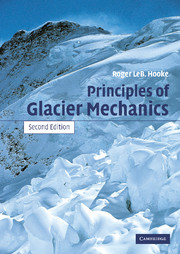Book contents
- Frontmatter
- Contents
- Preface to the first edition
- Preface to the second edition
- Physical constants relevant to ice
- Derived SI units and conversion factors
- 1 Why study glaciers?
- 2 Some basic concepts
- 3 Mass balance
- 4 Flow and fracture of a crystalline material
- 5 The velocity field in a glacier
- 6 Temperature distribution in polar ice sheets
- 7 The coupling between a glacier and its bed
- 8 Water flow in and under glaciers: geomorphic implications
- 9 Stress and deformation
- 10 Stress and velocity distribution in an idealized glacier
- 11 Numerical modeling
- 12 Applications of stress and deformation principles to classical problems
- 13 Finite strain and the origin of foliation
- 14 Response of glaciers to changes in mass balance
- Appendix: Problems
- References
- Index
12 - Applications of stress and deformation principles to classical problems
Published online by Cambridge University Press: 24 November 2009
- Frontmatter
- Contents
- Preface to the first edition
- Preface to the second edition
- Physical constants relevant to ice
- Derived SI units and conversion factors
- 1 Why study glaciers?
- 2 Some basic concepts
- 3 Mass balance
- 4 Flow and fracture of a crystalline material
- 5 The velocity field in a glacier
- 6 Temperature distribution in polar ice sheets
- 7 The coupling between a glacier and its bed
- 8 Water flow in and under glaciers: geomorphic implications
- 9 Stress and deformation
- 10 Stress and velocity distribution in an idealized glacier
- 11 Numerical modeling
- 12 Applications of stress and deformation principles to classical problems
- 13 Finite strain and the origin of foliation
- 14 Response of glaciers to changes in mass balance
- Appendix: Problems
- References
- Index
Summary
In this chapter, we will study some glaciologically significant problems for which an appreciation of the material presented in Chapters 9 and 10 is required. Our objective is not to provide a comprehensive overview of theoretical developments in glaciology, but rather to solidify the gains made in these preceding two chapters by applying the principles developed therein. In the course of this discussion, the student will be introduced to some definitive studies, frequently referenced in the glaciological literature.
Let us first consider the problem of closure of a cylindrical borehole, in part because this is relevant to our earlier discussion of glacier hydrology. Then we will investigate efforts to calculate basal shear stresses using a force balance model, followed by study of the creep of ice shelves. Finally, the problem of using borehole deformation experiments to obtain estimates of the values of the parameters in the flow law will round out the chapter.
Collapse of a cylindrical hole
The first problem we address is that of the closure of a cylindrical hole in ice. This problem was studied by Nye (1953) in the context of using closure rates of tunnels in ice to estimate the constants in Glen's flow law, and our development is based on Nye's paper. More recently, the theory has been used to analyze two problems in water flow at the base of a glacier: (1) the closure of a water conduit, and (2) leakage of water into or away from a subglacial conduit.
- Type
- Chapter
- Information
- Principles of Glacier Mechanics , pp. 315 - 348Publisher: Cambridge University PressPrint publication year: 2005



